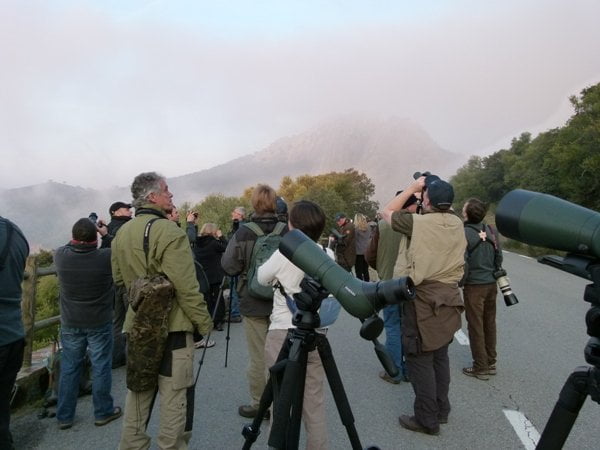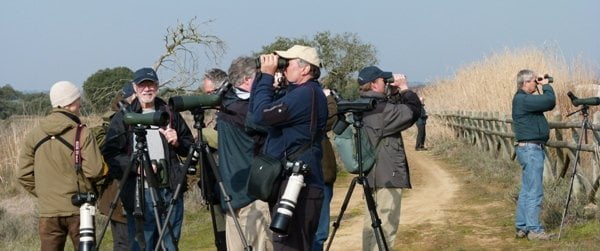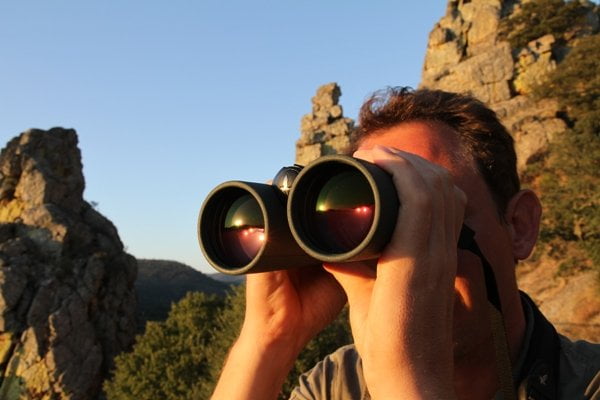“The most outstanding binoculars I have ever seen” and “unexpectedly comfortable and stable”. I cannot tell you how many times I have heard this recently. Which is a good thing. It helps me sleep and puts my little heart at ease.
The last couple of weeks have been nuts. The EL50 Swarovisions went in to serial production at the beginning of the year and we have just started to show it, but the highlight was our birding trip last week where we invited a small group of selected birding journalists and raptor experts to Extremadura (western Spain) for a bit of birding, socializing, and the opportunity to be the first to field test the EL50 Swarovisions.
Me, Bill Clarke, Dick Forsman, Gino Merchiers, Tim Appleton, Godfried Schreur, Pete Dunne (from left). Photo by Xavier Esteller
Now the thinking behind the birding trip was not just idly thought out. The thing is, this really is an incredible binocular, but typically birders write off 10×50 and 12×50 binoculars are being too big and heavy, and that you just cannot hold them still (the internet is littered with reports that birders should be using ~8x). And I was personally really sceptical of them when I first came across the idea. But the thing is, I – and everyone else that has had a chance to try them so far – has been surprised by them: there is just no way to adequately describe how they are, without having tried them. And, no-one believes a marketing guy (particularly when it is my baby). So it was important to get a bunch of well respected birding journalists and experts together so that they could make up their own mind.
Lesser Kestrels (Falco naumanni) were a sure sight in Trujillo, just 300m from our hotel. Photo by Steve Fletcher, who was able to join us on the first day.
I am a very excitable kinda guy and really like talking about things I enjoy (just wait for me to start blabbing on about tropical fish), but looking around the room at the product presentation talk, the scepticism in the room was almost tangible. Sure, they were likely intrigued as to what exactly lay before them in the box, but it seems they were unlikely to ever have believed what I was blabbing on about ergonomics and stability.
Birding with the EL50 Swarovision at the Salto del Gitano, Parque Nacional Monfragüe, Spain
The real test came the next day when we headed out to the stunning Monfragüe National Park – a wonderful rocky spine of cliffs cutting through the dehesan savannas, and sporting all sorts of wonderful birds. Our first sight in the morning was dozens of circling Griffon Vultures (Gyps fulvus) circling in the dawn mists. What an incredible sight!
 Birding at the Salto del Gitano, Monfragüe. Marc Duquet, Martin Hierck, Dick Forsman, Andreas Pittl, Linda Dunne, Pete Dunne, Godfried Schreur, Rebecca Armstrong, Stephan Gröhn, Anja Weidig, Martin Kelsey, Matthew Merrit, Dale Forbes (from left). Photo by Xavier Esteller.
Birding at the Salto del Gitano, Monfragüe. Marc Duquet, Martin Hierck, Dick Forsman, Andreas Pittl, Linda Dunne, Pete Dunne, Godfried Schreur, Rebecca Armstrong, Stephan Gröhn, Anja Weidig, Martin Kelsey, Matthew Merrit, Dale Forbes (from left). Photo by Xavier Esteller.
The slogan that we are using for the EL50 Swarovision binoculars is “SEEING IS KNOWING”. In that you kinda need to see it to believe it, but for bird identification, it is always better to know than to just believe/think. Which is exactly for what the binocular was designed in the first place, to allow you to see more detail. And everyone on the trip was stunned at just how well the designers had gotten this. Suddenly, we were seeing feather detail on the Griffon Vultures that we had never dreamed of before; Long-tailed Tits sprung to life; and the Spanish Imperial Eagle in the distance was way more recognizable.
I could not believe that I was using 12x optics, they were as steady as my own pair of 10 x 42, with an image quality that was truly remarkable…Swarovski have achieved the impossible, again! (Martin Kelsey, our incredible guide on his blog).
I’m finding myself looking at the same bird for longer, or looking at birds I know well more often, simply because I’m genuinely amazed at how user-friendly, ergonomic, and outstandingly bright these things are. They’re actually fun to use – more than a tool, they actually contribute to the day’s birding. (Charlie Moores on Talking Naturally (day 3 report).
 We had great views of Great Bustards (), including one individual flying directly over the group. Photo by Steve Fletcher
We had great views of Great Bustards (), including one individual flying directly over the group. Photo by Steve Fletcher
While out in the field, we managed to film some of the spontaneous reactions to the birding and binoculars, which we hope to put together in to a little youtube video to see what the pros are saying:
httpv://www.youtube.com/watch?v=Jc9M_6oH_2M
Happy birding,
Dale














Tremendous, Dale. Congratulations on such a successful launch. I cannot wait to get my hands on these bins!
I cannot wait until my wife starts her new job so I (and by that I mean: we) can afford these puppies!
Thanks for the post, Dale, but when does the tropical fish babbling start? That’s my field of expertise, so I might be able to contribute more than “nice post”, which is what I usually write on birding blogs.
@Mike, they really are great. are you going to be at any festivals any time soon? Clay has a couple that he will be taking along with him on his journeys.
@Kirby, tropical fish babbling happens any time someone pays me enough attention and shows the remotest interest. There is almost nothing better than diving a new area and drawing dozens of fish sketches on a slate to later try and ID. In that respected it is much like birding except you cannot take a pager and The Advanced (Fish) ID Guide with you.
What an opportunity, to try out new bins and get to see the Spanish birdlife. Where do we get specifications and what do we have to do to try them in an African environment….;-) (nudge, nudge, wink, wink).
Maybe a competition for a freebe would be a great idea? My Bosch and Lombs are getting a bit long in the tooth!!
@Gareth, by the beginning of March there should be at least a couple with Whysalls so you might be able to speak nicely with them. Otherwise I will probably have an EL12x50 with me down in KZN (and maybe Hartbeespoort) in April.
Congrats! Must be nice to be able to try those optics. Maybe you can get some new ones for Mike and Corey and send me the old ones for some of the local humble guides (actually poor) who cannot afford to buy even a $50 pair of binocs. I am speaking of Luis from Recinto 23 de Junio (Long-wattled Umbrellabird) who I have to lend him my eagle optics binocs when I visit his place.
Renato, that’s a terrific idea! 🙂
Dale, KZN is a bit far from me but Hartbeespoort is around the corner. Let me know if and when you will be here!
Great to hear about the reverse trend – going to higher mag binocs! The biggest issue for me, besides the brilliance of the image, is depth of field. How is the depth of field on these? Constantly refocusing on flying birds is an annoyance. Thanks!
@Wayne, while I have not looked at this specifically, one would imagine a 10×50 to have a better depth of field than a comparable 10×42 or 10×32 simply because one’s eyes would “stop down” the effective aperture of the binoculars under normal daylight conditions, making the image quality seem even more perfect, and increasing the depth of field.